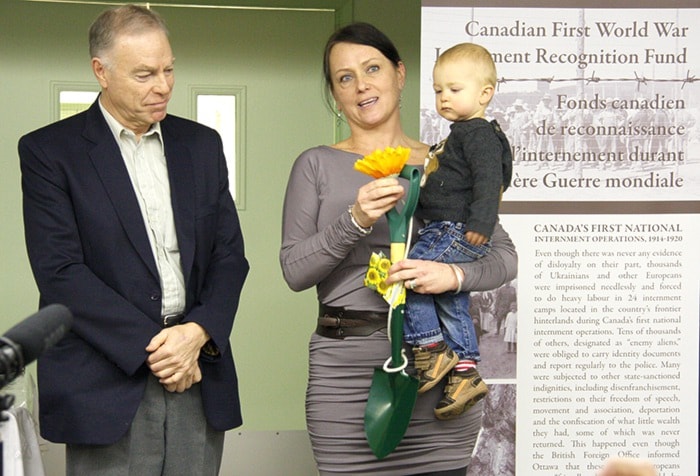The dark past of internment in Vernon, which has long been buried under shame and guilt, is coming to life.
Between 1914 and 1920, more than 96,000 Ukrainians and Europeans living in Canada were imprisoned behind the barbed wire fences of internment camps. They were forced to work for free, carving out highways.
“Thousands of men women and children were branded as enemy aliens,” explains Andrea Malysh, representative of the Ukrainian Canadian Civil Liberties Foundation and program manager of the Canadian First World War Internment Recognition Fund. “Not because of anything they had done, only because of where they had come from and who they were.”
Vernon was home to one of Canada’s 24 interment camps (at MacDonald Park).
And Vernon will soon be home to Canada’s first internment mural – at the Sutton building.
The first of 24 internment murals throughout Canada will be started in May, and expected to be unveiled by June 15, by artist Michelle Loughery. The final mural will be created in Ottawa in 2014 – marking the centennial of Canada’s first national internment operations.
“This is a very emotional day for me,” said Loughery during Wednesday’s launch of the initiative, called the Sunflower Project.
Loughery’s Gido (grandfather) spent his entire life searching for his brother who had been working in a camp and disappeared.
While in Vernon, working on a different project, Loughery stumbled across a letter from a taxidermist that stated that her great uncle was Prisoner of War No. 47 in a construction camp. It is believed he was one of the ones who died in the camp.
“For me now to paint that story and paint it across Canada and help Canada heal, it’s pretty emotional,” said Loughery.
The murals, created with the assistance of youth at risk and young artists, will tell the stories of local families affected. Vernon’s mural will share the story of a woman who chose to be interned in order to be with her husband.
“She stayed in the camp for six years with her children,” said Loughery.
But the murals are more than just a painting on the wall, it is a greater effort to heal the wounds of former internees and their families.
As part of that effort, a story collection process is underway.
“We need pictures, we need documents, we need voices of those that were affected (and their families),” said Lindsay Mitchell, executive director of Bridges Social Development – the charity working to collect and document stories.
Those with any stories of internment, whether they are historical or forms of imprisonment in today’s society, can email lougherymuralartworks@gmail.com, call 250-315-8517 or visit www.michelleloughery.org.
“Today is the start of the conversation,” said Loughery.
The sharing of stories doesn’t stop there. Through the Sunflower Project, efforts are being made to bring Canada’s dark chapter in history into the school curriculum.
“The average Canadian and youth still know very little about the internment,” said Lois Campbell, education liaison.
While this historic injustice is not a proud point in Canada’s history, it is hoped that through education all citizens can learn to hold their heads up high again.
“We’re going to help Canada heal,” said Loughery.
The City of Vernon is contributing $10,000 towards the project while the Downtown Vernon Association has provided $6,000, the St. Mary Ukrainian Orthodox Church is supporting the project with $1,000 and Vernon’s Ukrainian Women’s Association has contributed $200.
